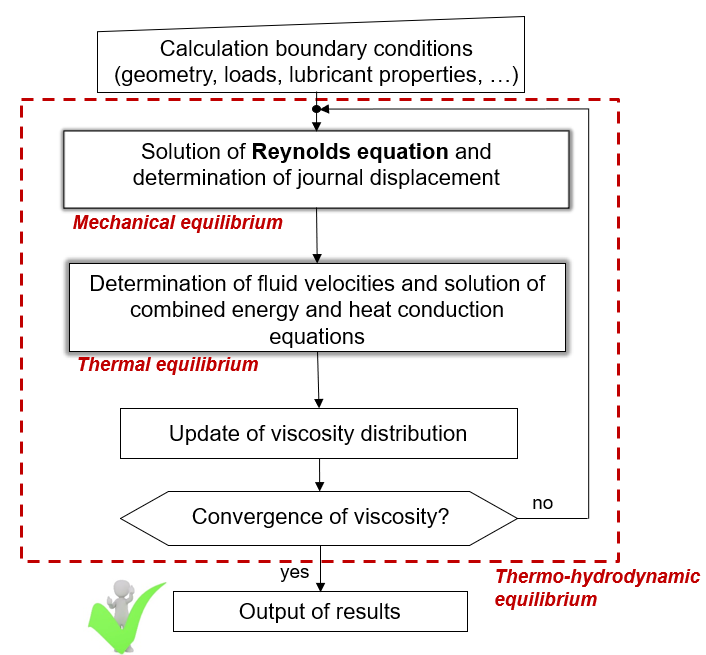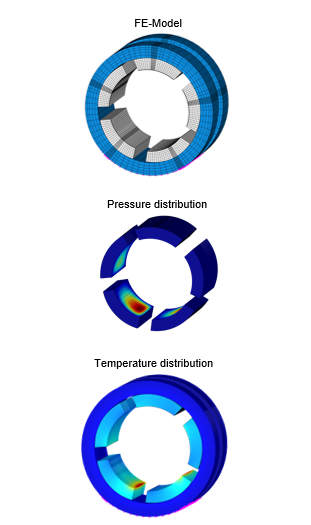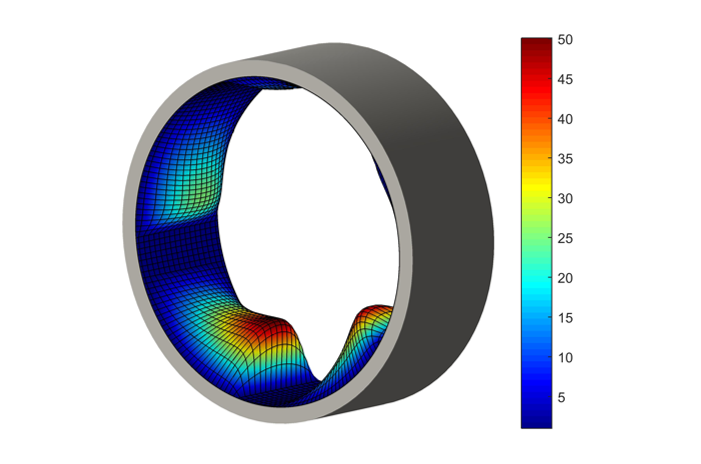Simulation of the radial plain bearing operating behavior
The COMBROS R plain bearing calculation program enables the isothermal and non-isothermal calculation of the static and dynamic bearing characteristics of hydrodynamically lubricated radial plain bearings as well as radial plain bearings that generate load capacity with the aid of high-pressure-fed hydrostatic pockets. The bearing bore geometry, including the profiling of the running surfaces, special pockets or grooves machined into the segment and the oil supply areas are precisely recorded. The main features of the COMBROS R scope of services are
General features
- Simultaneous (iterative) calculation of the pressure, temperature, viscosity and density distribution in the lubrication gap, the temperature distribution in the shaft and bearing shell and the effective lubrication gap geometry with approximate consideration of the most important ambient conditions
- 2D calculation of the pressure distribution in the entire lubrication gap including the sealing gaps, solution of the extended and generalized Reynolds equation
- Modeling of the flow in lubrication gap areas that are not completely filled using mass-preserving cavitation algorithms
- Solution of the thermal problem coupled via CHT boundary conditions (conjugate heat transfer) from energy equation for the gap (3D), heat conduction equation for the segments (3D) and heat conduction equation for the shaft (2D, homogenization of temperature in circumferential direction); definition of convective heat transfer at the free surfaces of segments and shaft
- Optional transient thermal analysis (heating/cooling during acceleration/deceleration of the machine)
- Consideration of mixed friction and the resulting wear processes
- Consideration of the pressure and temperature dependency of the oil viscosity
- Modeling of the lubricating film turbulence (change in the effective viscosity and heat conduction of the oil) through local description of the flow form and the transition from laminar to turbulent flow
- Determination of dynamic bearing characteristics such as stiffness and damping matrices on the basis of a disturbance calculation
Lubricant supply
- Determination of the lubrication condition for specified lubricant feed pressures, lubricant flow rates or average side flow temperatures, including the detection of insufficient lubrication conditions
- Consideration of the hydraulic coupling of the feed areas via the lubrication gap and external supply channels
- Modeling of the energetic coupling of the bearing segments as a result of hot oil carryover in the lubricant supply area
- Arrangement of any number of hydrostatic pockets on a circumferential coordinate
- Definition of pocket-specific lubricant flow rates
- Calculation of active hydrostatic or hybrid radial plain bearings whose pockets are supplied with constant inlet pressure or constant volume flow in different lubricant circuits, taking throttling characteristics into account
- Automated geometric modeling of deactivated hydrostatic pockets (with constant depth or circular geometry)
- Optional consideration of the dirt grooves frequently used in fixed-segment bearings
Special options for tilting pad bearings
- Consideration of compliance and tilting restraint (including damping) in the segment support for tilting pad bearings
- Modeling of segment elasticity in the disturbance calculation
- Determination of the coefficients of different dynamic bearing models (KC model, KCM model, complete tilting pad bearing model including the segment degrees of freedom)
Deformation analysis
- Approximate effective bearing clearance change due to thermal and mechanical deformations
- Automated coupling with common FE software to take into account the influence of local bearing deformations through co-simulation
- Time-efficient deformation analysis of numerous bearing types using an internal FE module
Furthermore, the COMBROS R program allows an almost exact adaptation of the simulation to the real system according to the knowledge of the operating engineer through a large number of free parameters for setting the calculation boundary conditions.



